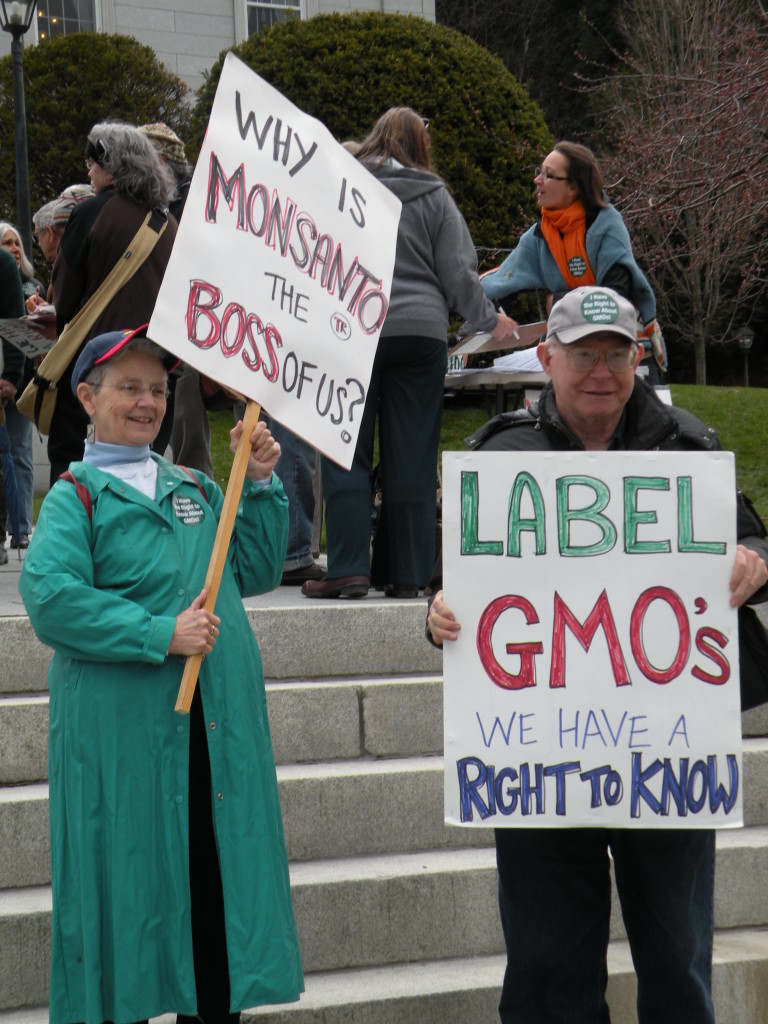On Tuesday, Californians asking for the right to know what is in their food were narrowly defeated by Monsanto’s $46 million dollar smear and fear campaign. For all of us who believe that GMO foods need to be labeled this was extremely disappointing, but it also shows us the importance of continuing our efforts all across the country. The hard work of our allies in California has educated the public about this issue, and helped create a national coalition calling for GMO labeling. Big money may have won the day, but it is clear that the American people will not be kept in the dark much longer!
Here in Vermont we have a chance to be the first state to require GMO foods to be labeled. This will not be easy, but with your help we can lead the country on this issue. Last year we showed the legislature just how important this issue is to Vermonters, and this year our voice will be even louder.
Please take a few minutes and write a brief letter to the editor of your local paper about why you support the labeling of genetically engineered food, and why you think the legislature should make Vermont the first state to label GMO foods. It only has to be 250 or 300 words, and probably won’t take you more than ten or fifteen minutes to write. I’ve put the submission pages/emails for most of the major papers around the state below, along with some basic talking points that we’ve found work well (both with the public and with legislators) and tips on writing letters to the editor.
If you have two or three more minutes, please also submit your letter to the other papers around the state; often multiple papers will print the same letter, multiplying your impact. And you know what your local weekly newspaper is – track them down online and submit it to them too!
GMO labeling talking points:
- Consumers have a right to know if their food is produced with genetic engineering, and to make informed choices about what they are eating and feeding their families.
- Over 50 countries around the world including the European Union, Japan, China, Australia and New Zealand already require the labeling of genetically engineered foods.
- Polls constantly show that over 90% of Americans believe that genetically engineered foods should be labeled.
- Labeling of genetically engineered foods can provide a critical method for tracking the potential health effects of eating genetically engineered foods.
- Over 20 other states are working to label GMOs
For more information about efforts to label genetically engineered foods, and about genetically engineered foods in general check out the resources page at www.vtrighttoknow.org
Helpful tips on writing letters to the editor adapted from Daniel Barlow, VBSR Public Policy Manager
Media outlets can sometimes get hundreds of letters each day, especially if there is a hot or contentious issue in debate. Here are a few tips that will ensure that your letter rises to the top of the pile.
1. Keep it short and to the point
Most newspapers only print letters that are 250-300 words long. Going over a newspaper’s limit will likely mean your letter won’t be published. Short and to the point is better – jump right in and tackle the subject matter head on.
2. Tell your story
Readers will connect with a personal story better than they will a letter that’s just dry facts. Personal stories that connect to a political issue are best. Use reputable facts or statistics to support your anecdote.
3. No jokes or attacks
Unless you are a professional comedian, jokes or gimmicks in letters to the editor usually don’t work. Stick to your story and the facts, but don’t sound stuffy or preachy.
4. Include all your contact information
Newspapers often need to verify that the letters are genuine, so include your full name, town of residence and your daytime phone number. Also, if you have a title that relates to the subject matter of the letter, such as being the owner of a local business or the executive director of an organization, include that under your name at the bottom of the letter.
5. Make it easy
Email is the preferred way to send in the letter. Don’t include it as an attachment; paste it right into the body of the email. Be sure to include a subject header that notes this is a letter to the editor and what the subject matter is (Ex- “Letter to editor: Vermont needs to label GMOs”).
Where to submit letters to the editor: (include your name, address & phone #)
Burlington Free Press: letters@burlingtonfreepress.com.
Times Argus: letters@timesargus.com
Rutland Herald: letters@rutlandherald.com
Bennington Banner: news@benningtonbanner.com
Brattleboro Reformer: news@reformer.com

